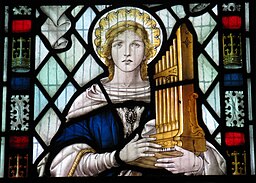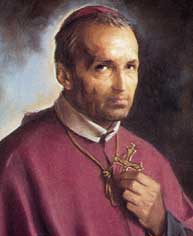Cecilia
Feast Day: November 22
Canonized: Pre-Congregation
With many of the early church martyrs, there are often stories and legends but not much historical information. Saint Cecilia probably lived in the second or third century, and tradition says she died about 177 AD. Although details of her life may be unknown to us, Saint Cecilia was one of the most revered early virgin martyrs of Rome, as evidenced by her name appearing in the Roman Canon of the Mass (Eucharistic Prayer 1). She is one of the seven women commemorated by name in the Roman Canon. There is evidence of a church named in her honor dating to the late fourth century. A feast day in honor of Saint Cecilia was celebrated as early as 545.
Cecilia was born in a wealthy Roman family and was a Christian by birth. Her family gave her in marriage to Valerius, a pagan nobleman. Cecilia promised to remain a virgin, and she was successful in persuading Valerius to respect her virginity on their wedding night. Later, Valerius was converted to Catholicism along with his brother, Tiburtius.
These two brothers dedicated themselves to burying the Christian martyrs, which was illegal. They were arrested and sentenced to death for refusing to renounce their religion.
Cecilia continued the work of converting people to the Christian faith and of burying the Christian dead, even though it was against the law. Hundreds were baptized through her witness and strength of faith. She planned to have her home preserved as a church after her death. Her refusal to worship false gods and her burying of the dead lead to her arrest.
Saint Cecilia was brought to trial and sentenced to death. It took several days for her to die, and it is said that she converted many people who came to care for her as she was dying. Saint Cecilia died lying on her right side with her hands crossed in prayer. The position of her fingers—three extended on her right hand, and one on the left—were her final silent profession of faith in the Holy Trinity, Three Persons in one God. Saint Cecilia was buried in the Catacomb of Saint Callistus.
In the Middle Ages, Saint Cecilia became a very popular saint. She is remembered today as the patron of musicians, composers, instrument makers, and poets. There is a story that Saint Cecilia was said to have heard heavenly music inside her heart when she was forced to marry the pagan Valerian. During her wedding, Cecilia sat and sang to God in her heart. Thus, she was declared to be the patron of musicians. Musical compositions, poems, art, and festivals have grown out of this story.
A few examples of the many artistic works about Saint Cecilia:
- Chaucer commemorates Saint Cecilia in his “Second Nun’s Tale.”
- John Dryden’s poem “A Song for Saint Cecilia’s Day” was set to music by Handel in his “Ode for Saint Cecilia’s Day.”
- Charles Gounod composed the Saint Cecilia Mass.
- Benjamin Britten composed the “Hymn to Saint Cecilia.”
Saint Cecilia reminds us of the ways that our music and art can lead us to praise God.
Connecting to Blest Are We® Parish and School
Grade 1, chapter 20





Comments are closed.